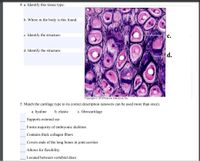
Human Anatomy & Physiology (11th Edition)
11th Edition
ISBN: 9780134580999
Author: Elaine N. Marieb, Katja N. Hoehn
Publisher: PEARSON
expand_more
expand_more
format_list_bulleted
Question

Transcribed Image Text:4. a. Identify this tissue type:
b. Where in the body is this found:
c. Identify the structure:
с.
d. Identify the structure:
d.
Copyright © 2010 Pearson Education, Inc.
5. Match the cartilage type to its correct description (answers can be used more than once).
a. hyaline
b. elastic
c. fibrocartilage
Supports external ear
Forms majority of embryonic skeleton
Contains thick collagen fibers
Covers ends of the long bones in joint cavities
Allows for flexibility
Located between vertebral discs
Expert Solution
This question has been solved!
Explore an expertly crafted, step-by-step solution for a thorough understanding of key concepts.
Step by stepSolved in 2 steps

Knowledge Booster
Similar questions
- 4. List the cell types found in nervous tissue, including their location and function.arrow_forward6. Areolar tissue has thick fibers made of that stain purple. that usually stain pink and thin fibers of 7. Cartilage cells called are found in a space called the S. The neural tissue has large that are assisted by smaller cells called 9. The only type of muscle tissue in the heart is 10. The majority of an adipocyte is made up of 11. The matrix of connective tissue is comprised of and Header 12. The area where epithelial tissue connects to the underlying tissues is called the 13. Which of the tissues you have seen is the easiest for you to identify? Why? (this question is your opinion)arrow_forward#3 Name and give the functions of the four basic types of tissues in the body.arrow_forward
- 9. The bracketed region af A' indicates structures called the ____. 10. Explain the advantage of tissue that is folded. 11. 'B' is part of the ____ layer and its tissue type is _____.arrow_forwardexplains how the three characteristics below affect the function of this cell, its system or / and the body as a whole. Make the connection between the structures and functions of the body. 1. Red blood cells that do not have a nucleus 2.The length and ramifications of neurons 3.the insulating layer of myelin around a neuronarrow_forward13. Identify the specific type of tissue indicated by the model below. 14. Identify the specific feature indicated by tag #14.arrow_forward
- 1. Regarding the standard anatomical position, which of the following statement is FALSE? a.Palm directed anteriorly b.Upper limb abducted c.Body is erect d.Eyes looking straight to the front 2. ____________ can commonly be found supporting epithelial cells.arrow_forward1. What is the main TYPE of tissue and specific KIND of tissue in the image below? a. epithelial tissue; stratified squamous epithelium b. loose connective tissue; reticular tissue c. epithelial tissue; simple squamous epithelium d. loose connective tissue; adipose tissue 2. For the same picture in #7, which organ is this tissue found in? a. liver b. fat in superficial fascia c. alveoli d. esophagusarrow_forward10. Match the following tissues on the right based on the characteristics provided: Place to appropriate letter on the line. :) a. Contains Place the letter below: fibroblasts, mast cells, Stratified Squamous Epithelium Dense Regular Connective Tissue Loose Arcolar Connective Tissue Dense Irregular Connective Tissue macrophages, neutrophils, collagen and elastic fibers and found in the papillary layer of the skin. Hyaline Cartlidge Cardiac Muscle b. Contains multiple layers of avascular squamous cells with tight junctions and a layer of keratinized cells c. Contains Densely packed collagen fibers, fibroblasts, and is found in tendons and ligaments. d. Dense but has little organization. Contains fibroblasts and anchors skin to hypodermis. Found in the reticular layer of the dermis. e. Found in the trachea, contains chondrocytes, and is avascular. f. Found in the hypodermis, anchors skin to the muscles. Muscle Muscle g. Found in the heart and contains gap junctions. Cardiac Skeletal…arrow_forward
- 1. a. Identify the type of tissue shown below. b. Identify the structure located at the end of the arrow c. Where in the body would you find this tissue type? 2. a. Identify the tissue type shown to the right: b. Where in the body would you find this tissue? 4arrow_forward2. What connections can you see between the concept of tissue integrity and upcoming professional clinical practise?arrow_forwardSerous fluid functions in: a. providing temperature stability. b. lubricating serous membranes as organs move in the cavity. c. protecting the organs from mechanical trauma. d. decreasing the weight of the organs and keeping them buoyantarrow_forward
arrow_back_ios
SEE MORE QUESTIONS
arrow_forward_ios
Recommended textbooks for you
 Human Anatomy & Physiology (11th Edition)Anatomy and PhysiologyISBN:9780134580999Author:Elaine N. Marieb, Katja N. HoehnPublisher:PEARSON
Human Anatomy & Physiology (11th Edition)Anatomy and PhysiologyISBN:9780134580999Author:Elaine N. Marieb, Katja N. HoehnPublisher:PEARSON Anatomy & PhysiologyAnatomy and PhysiologyISBN:9781259398629Author:McKinley, Michael P., O'loughlin, Valerie Dean, Bidle, Theresa StouterPublisher:Mcgraw Hill Education,
Anatomy & PhysiologyAnatomy and PhysiologyISBN:9781259398629Author:McKinley, Michael P., O'loughlin, Valerie Dean, Bidle, Theresa StouterPublisher:Mcgraw Hill Education, Human AnatomyAnatomy and PhysiologyISBN:9780135168059Author:Marieb, Elaine Nicpon, Brady, Patricia, Mallatt, JonPublisher:Pearson Education, Inc.,
Human AnatomyAnatomy and PhysiologyISBN:9780135168059Author:Marieb, Elaine Nicpon, Brady, Patricia, Mallatt, JonPublisher:Pearson Education, Inc., Anatomy & Physiology: An Integrative ApproachAnatomy and PhysiologyISBN:9780078024283Author:Michael McKinley Dr., Valerie O'Loughlin, Theresa BidlePublisher:McGraw-Hill Education
Anatomy & Physiology: An Integrative ApproachAnatomy and PhysiologyISBN:9780078024283Author:Michael McKinley Dr., Valerie O'Loughlin, Theresa BidlePublisher:McGraw-Hill Education Human Anatomy & Physiology (Marieb, Human Anatomy...Anatomy and PhysiologyISBN:9780321927040Author:Elaine N. Marieb, Katja HoehnPublisher:PEARSON
Human Anatomy & Physiology (Marieb, Human Anatomy...Anatomy and PhysiologyISBN:9780321927040Author:Elaine N. Marieb, Katja HoehnPublisher:PEARSON

Human Anatomy & Physiology (11th Edition)
Anatomy and Physiology
ISBN:9780134580999
Author:Elaine N. Marieb, Katja N. Hoehn
Publisher:PEARSON

Anatomy & Physiology
Anatomy and Physiology
ISBN:9781259398629
Author:McKinley, Michael P., O'loughlin, Valerie Dean, Bidle, Theresa Stouter
Publisher:Mcgraw Hill Education,

Human Anatomy
Anatomy and Physiology
ISBN:9780135168059
Author:Marieb, Elaine Nicpon, Brady, Patricia, Mallatt, Jon
Publisher:Pearson Education, Inc.,

Anatomy & Physiology: An Integrative Approach
Anatomy and Physiology
ISBN:9780078024283
Author:Michael McKinley Dr., Valerie O'Loughlin, Theresa Bidle
Publisher:McGraw-Hill Education

Human Anatomy & Physiology (Marieb, Human Anatomy...
Anatomy and Physiology
ISBN:9780321927040
Author:Elaine N. Marieb, Katja Hoehn
Publisher:PEARSON